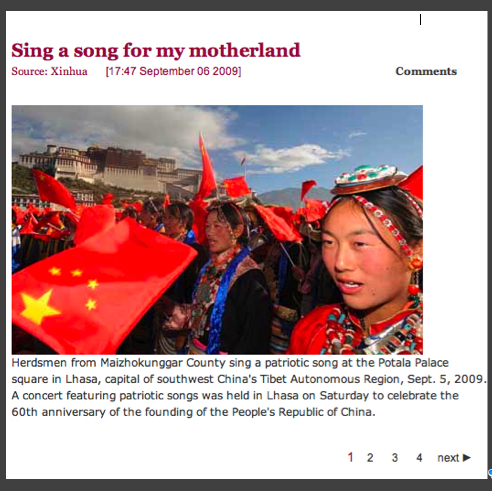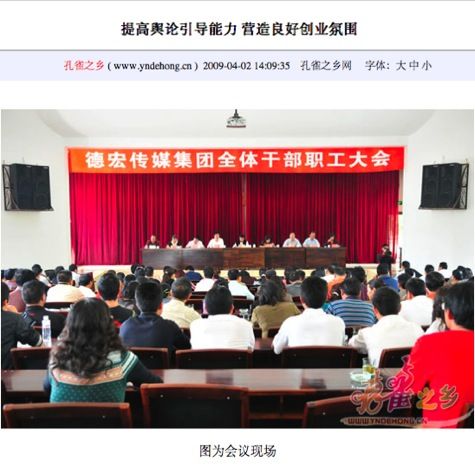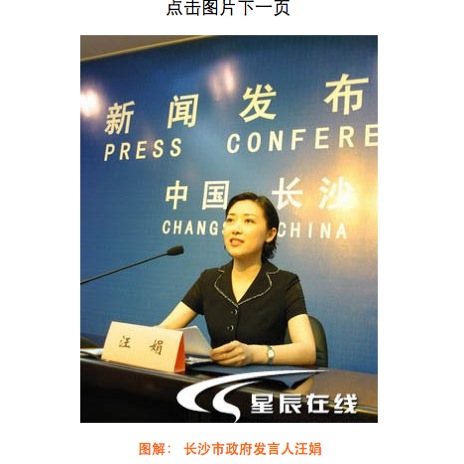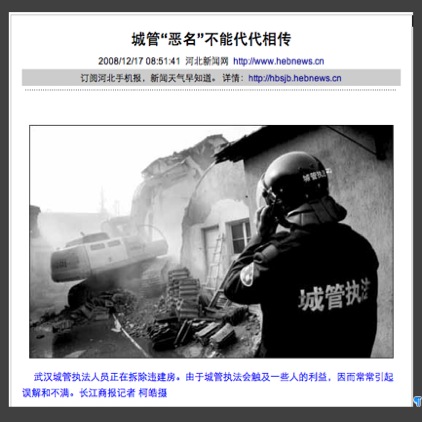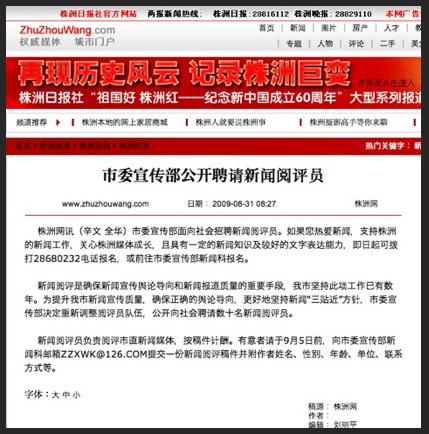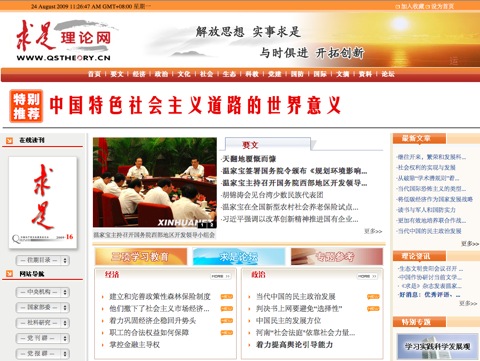Shenzhen's new media rules: is anyone paying attention?
By David Bandurski — Just as we were beginning to feel downright pessimistic about the prospects for China’s media, particularly around the 60th anniversary, AFP and the BBC picked up our mood with reports about how the city of Shenzhen is opening up to the press. This is very exciting news. It is unfortunately also utter nonsense.
The original font of misinformation was this article from the English-language China Daily, which drew attention to a document passed recently in Shenzhen called, “Shenzhen Municipal People’s Government Regulations on News Release Work” (深圳市人民政府新闻发布工作办法) .
The China Daily article, which carried the hopeful title “Law will guard journalists’ right to know,” quoted three sources, two of which were Shenzhen’s deputy propaganda chief, Xuan Zhuxi, and the head of the city government’s press office, Su Huijun.
These guys are basically the Tweedledum (party) and Tweedledee (government) of press control in Shenzhen. They must be laughing behind their sleeves right now about the rather generous foreign press they’ve gotten.
The third source quoted in the China Daily article, named as national radio reporter Li Qiang, sets up the shot for any of us who are prepared to be skeptical. Here’s what he says, in the final paragraph no less — which should suggest the writer of the report is winking at us too:
“It will be more convenient to get the right person with an improvement of the spokesman system. But the regulation doesn’t specify that the spokesman or his office must respond to an issue, which would be the real help for us journalists,” said Li Qiang, a reporter at a national radio station.
The online reports from the BBC and AFP suggest their news writers didn’t get the hint. (Here’s a clue: availability of spokespeople, not of information.)
The BBC piece attempts to indicate some skepticism — as in the single quotes in the headline, “China city ‘to open up to media’“. But the report is essentially a hasty rewrite of the China Daily piece, borrowing its quotes (except for the crucial one from Li Qiang) and adding stale little bits of boilerplate background:
Chinese media is tightly controlled by the state and independent investigative reporting is rare.
Shenzhen’s policy follows a relaxation of restrictions on foreign journalists after the Beijing Olympics.
How would any rational reader know up from down here? The first sentence seems to urge us to temper our optimism about these new regulations. The second seems to suggest the local regulations might be part of a general process of liberalization.
Sure, both statements in the block quote above are essentially factual. The problem is that they are shattered fragments not united in any way by conscientious reporting.
The only source for this news piece — discounting a couple of paraphrased statements from the BBC’s own Quentin Sommerville in Beijing — is the original China Daily report.
I’m picking unfairly on the BBC here, but the AFP story is independently identical.
And, yes, I am also feigning naivete here. This sort of thing happens all the time, right? Pick up an official news story (off the Web), move things around a bit, slot in a bit of background and, finally, just for good measure, sprinkle on some artificial skepticism.
But should it be happening all the time? Is it too much to ask, in other words, that a professional news service:
A. Seek two or three outside perspectives on their own?
B. Take a gander at the original policy document in question?
Concerning B . . . In the spirit of openness, I suppose, Shenzhen quickly made the full version of this “media” policy available online. Wouldn’t it be wonderful if people actually read it before they wrote about it? (Having said that I’m starting to feel genuinely naive.)
But let’s do take a look. Even a cursory one will suffice.
First of all, let’s remember that this document is called: “Shenzhen Municipal People’s Government Regulations on News Release Work.” Right. So the key question has to be: what exactly is meant by “news release work”?
OK. Moving on.
We can just ignore the first clause of Article One. All that language about how the purpose of the regulation is to “increase the level of transparency in government” and to “create a sunshine government” — that’s just the pretty preamble telling us what Shenzhen officials want us to think this document is all about.
Clause Two gives us the definition of “news release work” we’re looking for:
“News release work” refers in these regulations to the use of press spokespersons or other authorized forms by the government and administrative departments (hereafter called administrative organs) to release information concerning these administrative organs through news media and other channels, expressing [the government’s] arguments and positions, addressing social concerns, answering questions from the public and otherwise strengthening the work of connecting with the public.
In the China Daily/AFP/BBC version of the story, Shenzhen media seem to be actively empowered by the new regulations. The BBC suggests that “officials could be sacked or reprimanded if they do not respond quickly to media requests.” China Daily tells us that officials “who fail to provide accurate and proper information to the media will face punishments ranging from public criticism to dismissal from their post.”
But Clause Two of Article One makes it patently clear that these regulations are really about government public relations, and are not a real mandate for official accountability.
It is still the government’s prerogative to decide what information is “accurate” or “proper.” The only substantive demand on government offices is that they make sure they are equipped with designated and trained press spokespeople. If they fail to do this “news release work” adequately — holding press conferences regularly to explain what they are busy doing, making statements to the press in the event of sudden-breaking incidents, etcetera — they may be censured.
In point of fact, this has nothing to do with a relaxation of media policy. Since when — and where — has the frequency of government press conferences ever been an adequate measure of press freedom?
Clause Five of Article One does mention a number of positive principles supposed to underpin these regulations, such as the principle of “information openness” and the principle of “truthfulness.” But similar language is already abundant in other local and national legislation. There is the 2006 “Opinion on the Implementation of the ‘Sunshine Project’ in Shenzhen.” And of course there is also the “National Ordinance on Openness of Government Information.”
These local and national regulations have failed to yield real openness because they do not, and cannot, create institutional guarantees of accountability. They are window dressing on a system with no real checks and balances.
Obviously, the most important invisible actor here is China’s news control and propaganda system. There is the party’s Central Propaganda Department, and of course Shenzhen’s propaganda office. On the government side, at the national level, there is the State Council Information Office taking charge of internet controls — and this bureaucracy extends down also to Shenzhen’s press office. Remember Tweedledee and Tweedledum, those two guys laughing behind their sleeves?
At one point in the regulations, this looming system of news controls peeks out from behind the curtain. The language in Clause 19 of Article 4, on procedural specifics, states that: “Information of a routine nature for active release should be released within 7 working days of its preparation and approval [for release].”
And who do you suppose is taking the lead in this “approval” process? That’s right. The propaganda office, whose job it is to defend the interests of party leaders in Shenzhen.
“Shenzhen is a noted laboratory for reform,” reported the AFP piece, underlining the assumption that, here again, was proof of the axiom. But after a glance of analysis this document begins to look much less like reform, don’t you think?
One of the saddest things in this little narrative is that it is the official English-language China Daily that ultimately provides us with the most useful information about Shenzhen’s regulations. The quotes from Shenzhen officials are from China Daily, which also gives us the only real dissenting voice in the form of the cautious, shoulder-shrugging remarks of national radio reporter Li Qiang.
Of course we can shrug our own shoulders and say this is no big deal. But I have this sinking suspicion we are glimpsing the future of Web-based global journalism in this copy, paste and pretend to parse approach to news writing.
And if this is true, China’s leaders may really be on to something with this idea they have of more actively influencing international public opinion by getting their own version of the story out quickly. International media, with their expedient eyes on the balance sheets, may very well follow on the heels of the Pied Pipers of Beijing.
We have arrived now in a place of even-handed despondency, with two pessimisms to take the place of one.
FURTHER READING:
“Shenzhen makes itself media accountable, somewhat,” Tibetan Review, September 17, 2009
“Shenzhen’s ‘Sunshine Project’ Ensures People’s Right to Know” [Chinese], Xinhua News Agency, January 6, 2006
“Shenzhen Municipal People’s Government Regulations on News Release Work” (深圳市人民政府新闻发布工作办法)
[Posted by David Bandurski, September 21, 2009, 9:21am HK]
